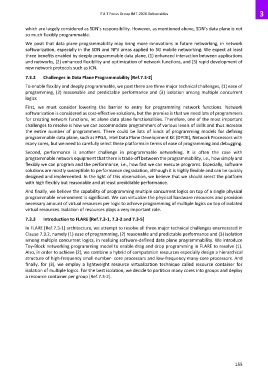Page 161 - ITU-T Focus Group IMT-2020 Deliverables
P. 161
ITU-T Focus Group IMT-2020 Deliverables 3
which are largely considered as SDN’s responsibility. However, as mentioned above, SDN’s data plane is not
so much flexibly programmable.
We posit that data plane programmability may bring more innovations in future networking, in network
softwarization, especially in the SDN and NFV areas applied to 5G mobile networking. We expect at least
three benefits enabled by deeply programmable data plane, (1) enhanced interaction between applications
and networks, (2) enhanced flexibility and optimization of network functions, and (3) rapid development of
new network protocols such as ICN.
7.3.2 Challenges in Data Plane Programmability [Ref.7.3-2]
To enable flexibly and deeply programmable, we post there are three major technical challenges, (1) ease of
programming, (2) reasonable and predictable performance and (3) isolation among multiple concurrent
logics
First, we must consider lowering the barrier to entry for programming network functions. Network
softwarization is considered as cost-effective solutions, but the premise is that we need lots of programmers
for creating network functions, let alone data plane functionalities. Therefore, one of the most important
challenges to resolve is how we can accommodate programmers of various levels of skills and thus increase
the entire number of programmers. There could be lots of kinds of programming models for defining
programmable data plane, such as FPGA, Intel Data Plane Development Kit (DPDK), Network Processors with
many cores, but we need to carefully select these platforms in terms of ease of programming and debugging.
Second, performance is another challenge in programmable networking. It is often the case with
programmable network equipment that there is trade-off between the programmability, i.e., how simply and
flexibly we can program and the performance, i.e., how fast we can execute programs. Especially, software
solutions are mostly susceptible to performance degradation, although it is highly flexible and can be quickly
designed and implemented. In the light of this observation, we believe that we should select the platform
with high flexibly but reasonable and at least predictable performance.
And finally, we believe the capability of programming multiple concurrent logics on top of a single physical
programmable environment is significant. We can virtualize the physical hardware resources and provision
necessary amount of virtual resources per logic to achieve programming of multiple logics on top of isolated
virtual resources. Isolation of resources plays a very important role.
7.3.3 Introduction to FLARE [Ref.7.3-1, 7.3-2 and 7.3-5]
In FLARE [Ref.7.3-1] architecture, we attempt to resolve all three major technical challenges enumerated in
Clause 7.3.2, namely (1) ease of programming, (2) reasonable and predictable performance and (3) isolation
among multiple concurrent logics, in realizing software-defined data plane programmability. We introduce
Toy-Block networking programming model to enable drag and drop programming in FLARE to resolve (1).
Also, in order to achieve (2), we combine a hybrid of computation resources especially design a hierarchical
structure of high-frequency small-number- core processors and low-frequency many-core processors. And
finally, for (3), we employ a lightweight resource virtualization technique called resource container for
isolation of multiple logics. For the best isolation, we decide to partition many cores into groups and deploy
a resource container per group [Ref.7.3-2].
155

